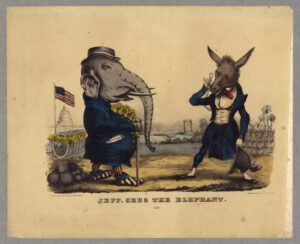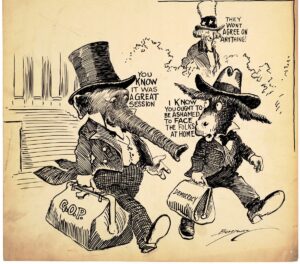» posted on Saturday, August 22nd, 2020 by Linda Lou Burton
The Better To Hear?
 Linda Lou Burton posting from Little Rock, Arkansas – I got curious, and went on a search. When, I wondered, did the Democrats and Republicans begin using donkeys and elephants as party symbols? And more puzzling, WHY? A donkey, aka, JACKASS, with an annoying bray? And a big lumbering elephant who would surely eat you out of house and home if you let it in?
Linda Lou Burton posting from Little Rock, Arkansas – I got curious, and went on a search. When, I wondered, did the Democrats and Republicans begin using donkeys and elephants as party symbols? And more puzzling, WHY? A donkey, aka, JACKASS, with an annoying bray? And a big lumbering elephant who would surely eat you out of house and home if you let it in?
Turns out the story actually does begin with somebody calling somebody a jackass. Andrew Jackson, back in the election of 1828, was depicted as being “stubborn as a jackass” and Andrew just flat turned it around and, with a donkey as a mascot, beat out John Quincy Adams! Remember, Adams became president in 1824, though Jackson had won the popular vote. But Jackson tried it again, and whupped Adams you-know-what. It was a landslide.
The “mascot” idea didn’t really catch on until the mid-1800’s however, and I found some interesting examples of political cartoons. The first I’ll share, with full credit to American Antiquarian, explains what “seeing the elephant” generally referred to. Citation: “Jeff. Sees the Elephant,” The News Media and the Making of America, 1730-1865, https://americanantiquarian.org/earlyamericannewsmedia/items/show/120
Jeff. Sees the Elephant
This color lithograph published by E. B. & E. C. Kellogg of Hartford, Connecticut, and George Whiting of New York City dates from 1861 or 1862. It is believed to be the first time that the elephant and donkey appear together depicting the Republican and Democratic parties. The phrase “to see the elephant” was a common expression in the mid-nineteenth century and often appears in descriptions of both the gold rush and the Civil War. It is thought to originate with the circus. The large mammals such as lions and elephants were the climax of the circus experience and always appeared toward the end of the performances. When one had “seen the elephant” then one had seen the entire show. The term then gradually became synonymous with experiencing or” seeing it all.”
 In this image the elephant bedecked in formal attire with accessories festooned with stars and stripes and the U.S. Constitution in his pocket represents the Union. The cannon barrels protruding from his waistcoat, and the multitude of even more cannon and cannon balls behind him, represent the great military prowess of the Northern states. Eventually Abraham Lincoln (1809-65) took on the elephant as his mascot. By his reelection campaign in 1864, trunks and tusks were used in his campaign materials and “the elephant is coming” became his slogan. Republicans have been associated with elephants ever since.
In this image the elephant bedecked in formal attire with accessories festooned with stars and stripes and the U.S. Constitution in his pocket represents the Union. The cannon barrels protruding from his waistcoat, and the multitude of even more cannon and cannon balls behind him, represent the great military prowess of the Northern states. Eventually Abraham Lincoln (1809-65) took on the elephant as his mascot. By his reelection campaign in 1864, trunks and tusks were used in his campaign materials and “the elephant is coming” became his slogan. Republicans have been associated with elephants ever since.
This humorous image also contains Jefferson Davis (1808-89) as a donkey, peering through a monocle at the elephant and his enormous quantity of arms and armaments. Behind him is an army of “jackasses” carrying pitchforks, rakes, brooms, and scythes, which are clearly no match for the North’s cannon. The gallows in the center background of the image portends a bleak future for the Confederacy. Jefferson Davis was a lifelong Democrat, having served as a U. S. representative and senator before becoming president of the Confederacy after the South seceded.
 A fellow named Thomas Nast (1840 – 1902), a German-born American caricaturist, is considered the “Father of American Political Cartoons.” He was associated with Harper’s Weekly, and popularized the donkey-elephant symbols in his work. In general, his political cartoons supported American Indians and Chinese Americans. He advocated the abolition of slavery, opposed racial segregation, and deplored the violence of the Ku Klux Klan. Harper’s Weekly, and Nast, played an important role in the election of Abraham Lincoln in 1864, and Ulysses S Grant in 1868 and 1872.
A fellow named Thomas Nast (1840 – 1902), a German-born American caricaturist, is considered the “Father of American Political Cartoons.” He was associated with Harper’s Weekly, and popularized the donkey-elephant symbols in his work. In general, his political cartoons supported American Indians and Chinese Americans. He advocated the abolition of slavery, opposed racial segregation, and deplored the violence of the Ku Klux Klan. Harper’s Weekly, and Nast, played an important role in the election of Abraham Lincoln in 1864, and Ulysses S Grant in 1868 and 1872.
Clifford Berryman (1869 – 1949) was another influential political cartoonist; he worked with both the Washington Post and Washington Star. He drew thousands of cartoons commenting on American presidents, lampooning both of the Roosevelts and Harry Truman.  A Pulitzer Prize winner, his cartoons are in the National Archives, and the Library of Congress today.
A Pulitzer Prize winner, his cartoons are in the National Archives, and the Library of Congress today.
I found hundreds of donkey-elephant images during my search – they seem to be handy critters for “poking fun” or making serious accusations in a clever, right-to-the-point manner. The DEFINITION of each animal didn’t go far in explaining how they keep winding up on bumper stickers every four years though:
- Donkey: a domesticated hoofed mammal of the horse family with long ears and a braying call, used as a beast of burden; an ass.
- Elephant: a heavy plant-eating mammal with a prehensile trunk, long curved ivory tusks, and large ears, native to Africa and southern Asia; the largest living land animal.
Then I thought of PETA
PETA had been thinking about it too, and published a piece about it. In a showdown, which real animal would win? PETA called it a tie. https://www.peta.org/blog/elephants-vs-donkeys-win/
- Physical prowess: Elephants are active for 18 hours a day and can travel up to 30 miles a day. Donkeys can run up to 30 miles per hour and are sure-footed on rocky mountain crags.
- Compassion: Elephants will pitch in to help a mother elephant rescue her drowning baby. Donkeys are affectionate and patient with children.
- Beauty: Standing up to 13 feet tall with trunks that can reach for 7 feet, elephants make a majestic sight. Donkeys are beautiful with soft coats of fawn, chocolate, red, or black fur and a graceful gait.
- Intelligence: Elephants figured out a shortcut researchers hadn’t thought of in an experiment to see if they could work together, both pulling opposite ends of a rope, in order to move food close to them. Donkeys are smart too; companion donkeys answer to their names, go for walks off leash, and can even learn to pull carts through obstacle courses.
- Enjoying leisure time: Elephants like to cool off by using their trunks to spray water all over their bodies. Donkeys like to roll on their backs in the grass or dirt and love receiving treats and ear rubs.
One thing is clear. Both animals have big ears. The better to hear you with?
